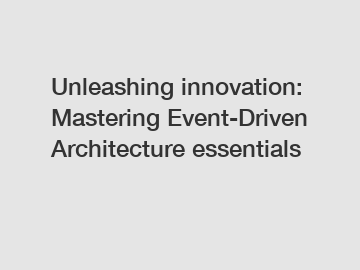Unleashing innovation: Mastering Event-Driven Architecture essentials
Unleashing innovation: Mastering Event-Driven Architecture essentials.
In today's rapidly changing business landscape, organizations are constantly looking for ways to outperform their competition, drive growth, and deliver exceptional customer experiences. The key to achieving these goals lies in embracing digital transformation and leveraging advanced technologies that enable quick and seamless decision-making. Event-Driven Architecture (EDA) is one such technology that has gained significant traction in recent years.
EDA is a powerful approach that allows businesses to respond to events in real-time, enabling them to make informed decisions and take immediate actions. Unlike traditional systems that rely on request-response models, EDA focuses on capturing and processing events that occur within the organization or the external environment. These events can be anything from customer interactions, market fluctuations, or even changes in regulatory policies.

With EDA, organizations can break down data silos and create a unified view of their operations, empowering them to respond swiftly to market demands and customer preferences. By adopting an event-driven mindset, businesses can drive innovation, improve operational efficiency, and enhance the overall customer experience.
However, mastering the essentials of Event-Driven Architecture requires a deep understanding of its key components and best practices. Let's dive into some essential concepts to unleash innovation through EDA:
1. Event-driven mindset: Shifting from a traditional request-response mindset to an event-driven mindset is crucial. It requires organizations to anticipate and prepare for events proactively, rather than waiting for requests to trigger actions. This shift enables businesses to become more agile, responsive, and proactive in their decision-making processes.
2. Event sourcing: Event sourcing is a technique used in EDA to capture and store all changes in the system as a sequence of events. By storing events as a single source of truth, organizations can reconstruct the system's state at any given point in time, enabling advanced analytics and enabling real-time decision-making.
3. Asynchronous communication: EDA relies on asynchronous communication between different components and services. This decouples systems, allowing them to work independently and enabling scalability and resilience. Asynchronous communication also allows components to process events in parallel, promoting faster and more efficient processing.
4. Reactive systems: Building reactive systems is a fundamental aspect of EDA. Reactive systems are designed to be responsive, resilient, elastic, and message-driven. They can handle large numbers of concurrent events, ensuring that no data is lost or delayed during processing.
5. Event-driven architecture patterns: EDA provides various architectural patterns to capture, process, and propagate events within an organization. Patterns such as Event-driven Messaging, Event Collaboration, and CQRS (Command Query Responsibility Segregation) help organizations design robust, scalable, and loosely coupled systems that can handle complex event flows effectively.
6. Event-driven analytics: EDA opens up new possibilities for advanced analytics by providing a real-time stream of events. By applying analytics to event data, organizations can gain valuable insights, identify patterns, and make data-driven decisions in real-time.
7. Event-driven integration: Integrating disparate systems and services is a common challenge for organizations. EDA simplifies integration by providing a standard event format and protocol for communication. This enables easy integration of applications, services, and external systems, facilitating seamless data flow and reducing complexity.
Mastering the essentials of Event-Driven Architecture requires a blend of technical expertise, creativity, and a willingness to embrace innovation. Organizations that succeed in adopting EDA will reap the benefits of faster time-to-market, improved agility, enhanced customer experiences, and increased competitive advantage.
In conclusion, Event-Driven Architecture is more than just a buzzword; it is a transformative approach that enables organizations to harness the power of real-time events for driving innovation. By adopting an event-driven mindset and leveraging the core principles and best practices of EDA, businesses can unleash their full potential, stay ahead of the curve, and thrive in today's dynamic business environment. So, are you ready to embrace the event-driven revolution and unlock the doors to innovation?
Are you interested in learning more about Event Transformer Github, messaging queue tools, Event Stream Connectors? Contact us today to secure an expert consultation!


